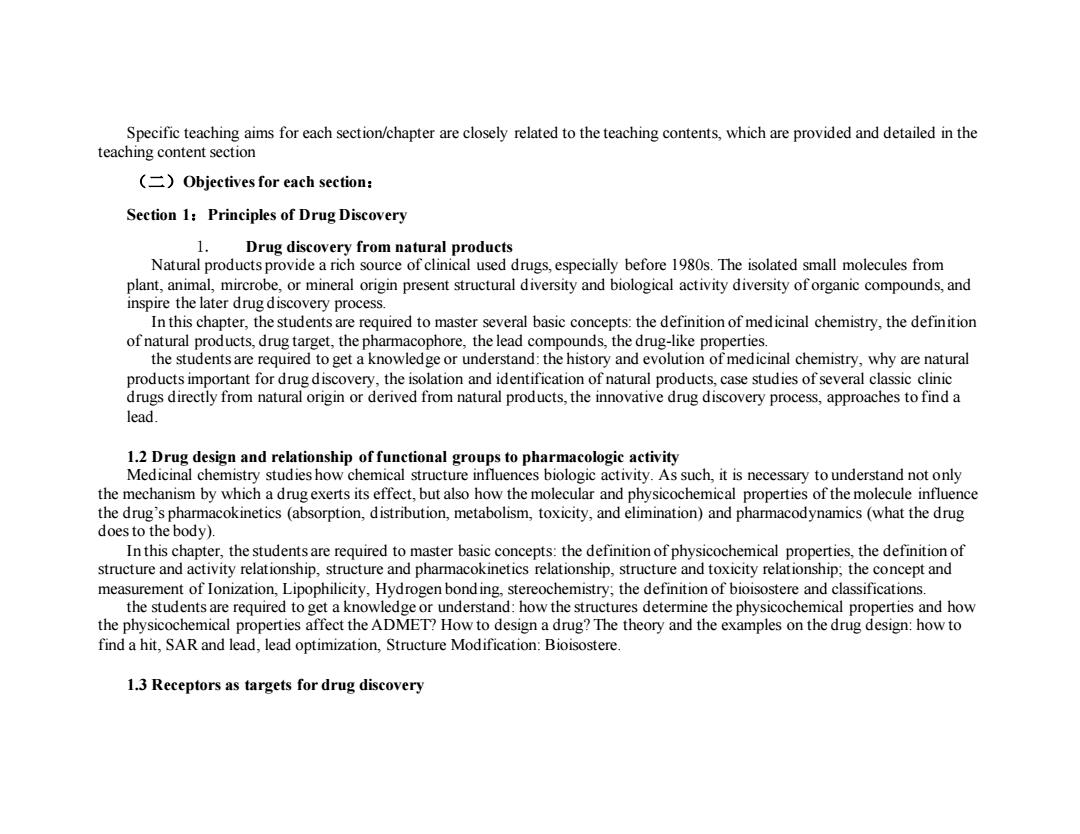正在加载图片...

Specific teaching aims for each section/chapter are closely related to the teaching contents,which are provided and detailed in the teaching content section (Objectives for each section: Section 1:Principles of Drug Discovery 1.Drug discovery from natural products Natural products provide a rich source of clinical used drugs,especially before 1980s.The isolated small molecules from plant,animal,mircrobe,or mineral origin present structural diversity and biological activity diversity of organic compounds,and inspire the later drug discovery process. In this chapter,the students are required to master several basic concepts:the definition of medicinal chemistry,the definition of natural products,drug target,the pharmacophore,the lead compounds,the drug-like properties. the students are required to get a knowledge or understand:the history and evolution of medicinal chemistry,why are natural products important for drug discovery,the isolation and identification of natural products,case studies of several classic clinic drugs directly from natural origin or derived from natural products,the innovative drug discovery process,approaches to find a lead. 1.2 Drug design and relationship of functional groups to pharmacologic activity Medicinal chemistry studies how chemical structure influences biologic activity.As such,it is necessary to understand not only the mechanism by which a drug exerts its effect,but also how the molecular and physicochemical properties of the molecule influence the drug's pharmacokinetics (absorption,distribution,metabolism,toxicity,and elimination)and pharmacodynamics(what the drug does to the body). In this chapter,the students are required to master basic concepts:the definition of physicochemical properties,the definition of structure and activity relationship,structure and pharmacokinetics relationship,structure and toxicity relationship;the concept and measurement of Ionization,Lipophilicity,Hydrogen bond ing,stereochemistry;the definition of bioisostere and classifications. the students are required to get a knowledge or understand:how the structures determine the physicochemical properties and how the physicochemical properties affect the ADMET?How to design a drug?The theory and the examples on the drug design:how to find a hit,SAR and lead,lead optimization,Structure Modification:Bioisostere. 1.3 Receptors as targets for drug discoverySpecific teaching aims for each section/chapter are closely related to the teaching contents, which are provided and detailed in the teaching content section (二)Objectives for each section: Section 1:Principles of Drug Discovery 1. Drug discovery from natural products Natural products provide a rich source of clinical used drugs, especially before 1980s. The isolated small molecules from plant, animal, mircrobe, or mineral origin present structural diversity and biological activity diversity of organic compounds, and inspire the later drug discovery process. In this chapter, the students are required to master several basic concepts: the definition of medicinal chemistry, the definition of natural products, drug target, the pharmacophore, the lead compounds, the drug-like properties. the students are required to get a knowledge or understand: the history and evolution of medicinal chemistry, why are natural products important for drug discovery, the isolation and identification of natural products, case studies of several classic clinic drugs directly from natural origin or derived from natural products, the innovative drug discovery process, approaches to find a lead. 1.2 Drug design and relationship of functional groups to pharmacologic activity Medicinal chemistry studies how chemical structure influences biologic activity. As such, it is necessary to understand not only the mechanism by which a drug exerts its effect, but also how the molecular and physicochemical properties of the molecule influence the drug’s pharmacokinetics (absorption, distribution, metabolism, toxicity, and elimination) and pharmacodynamics (what the drug does to the body). In this chapter, the students are required to master basic concepts: the definition of physicochemical properties, the definition of structure and activity relationship, structure and pharmacokinetics relationship, structure and toxicity relationship; the concept and measurement of Ionization, Lipophilicity, Hydrogen bonding, stereochemistry; the definition of bioisostere and classifications. the students are required to get a knowledge or understand: how the structures determine the physicochemical properties and how the physicochemical properties affect the ADMET? How to design a drug? The theory and the examples on the drug design: how to find a hit, SAR and lead, lead optimization, Structure Modification: Bioisostere. 1.3 Receptors as targets for drug discovery